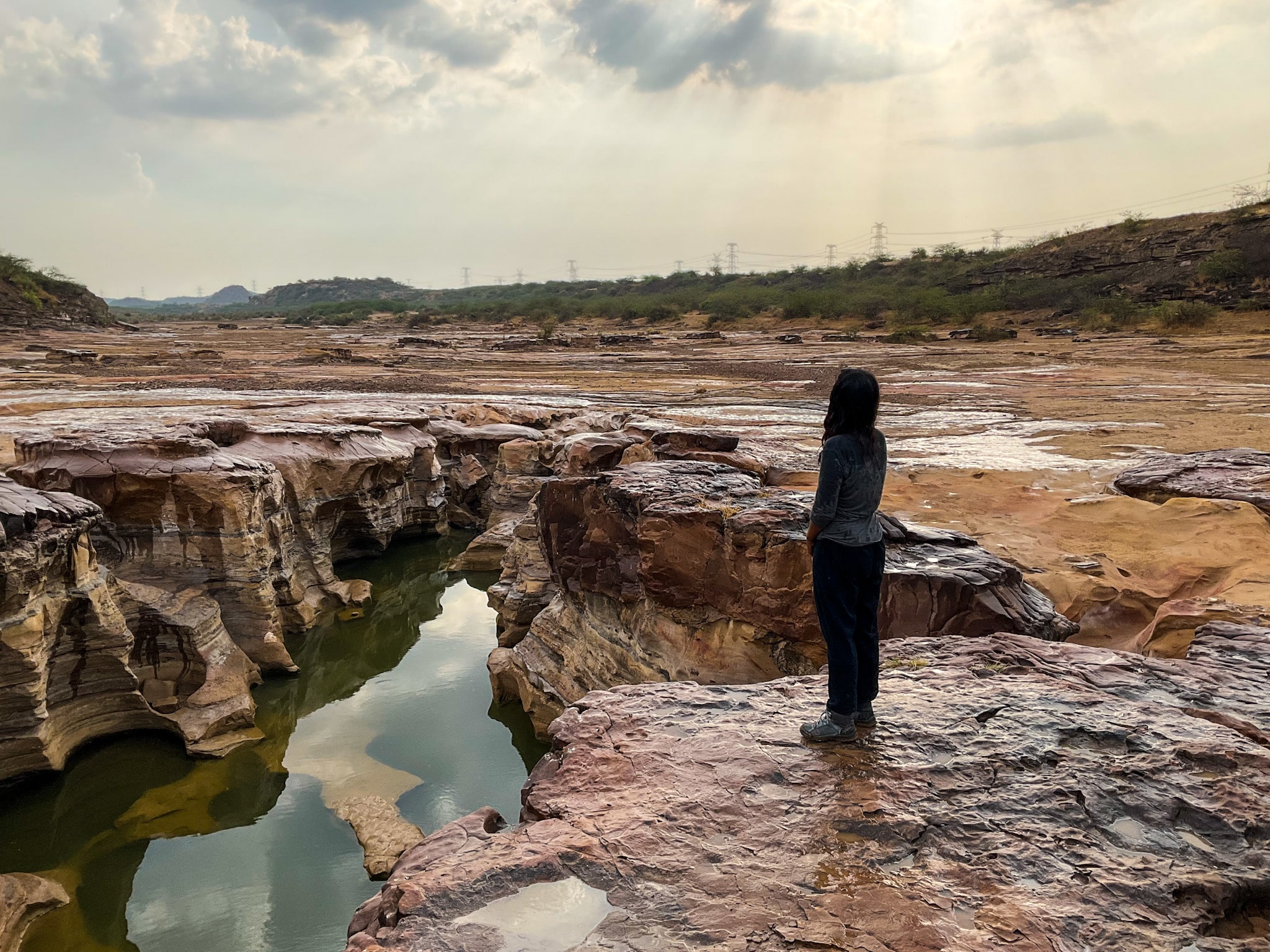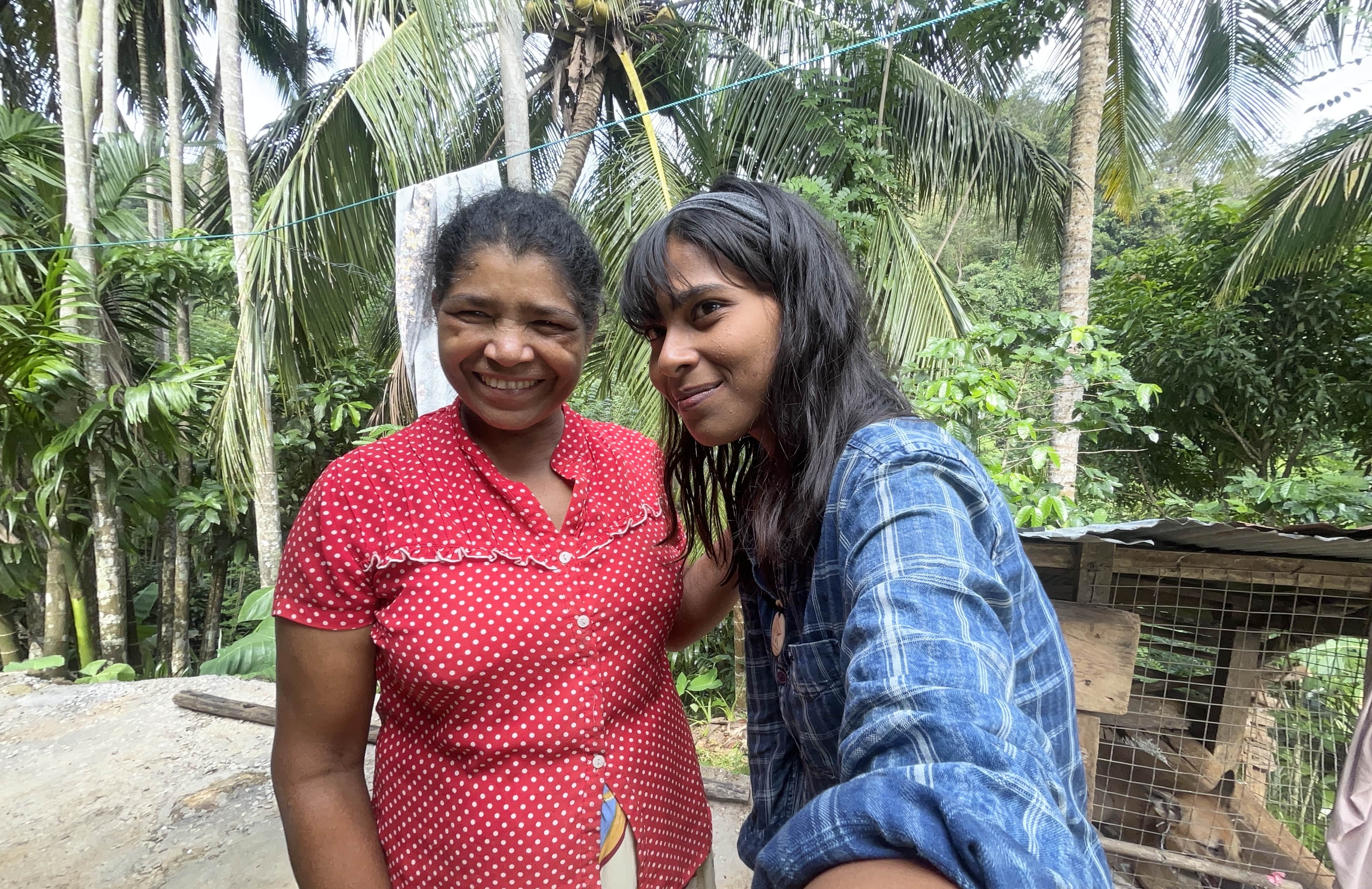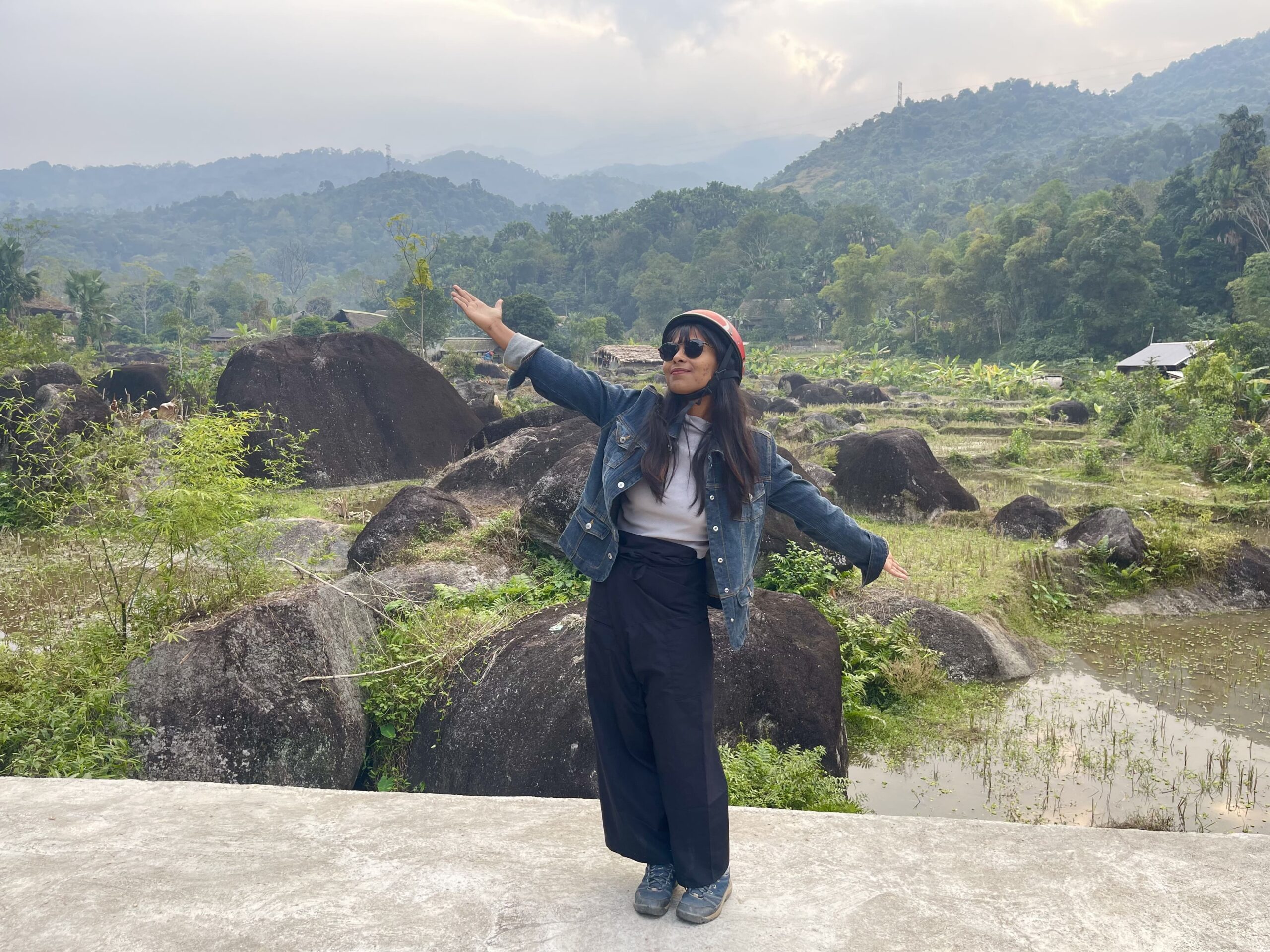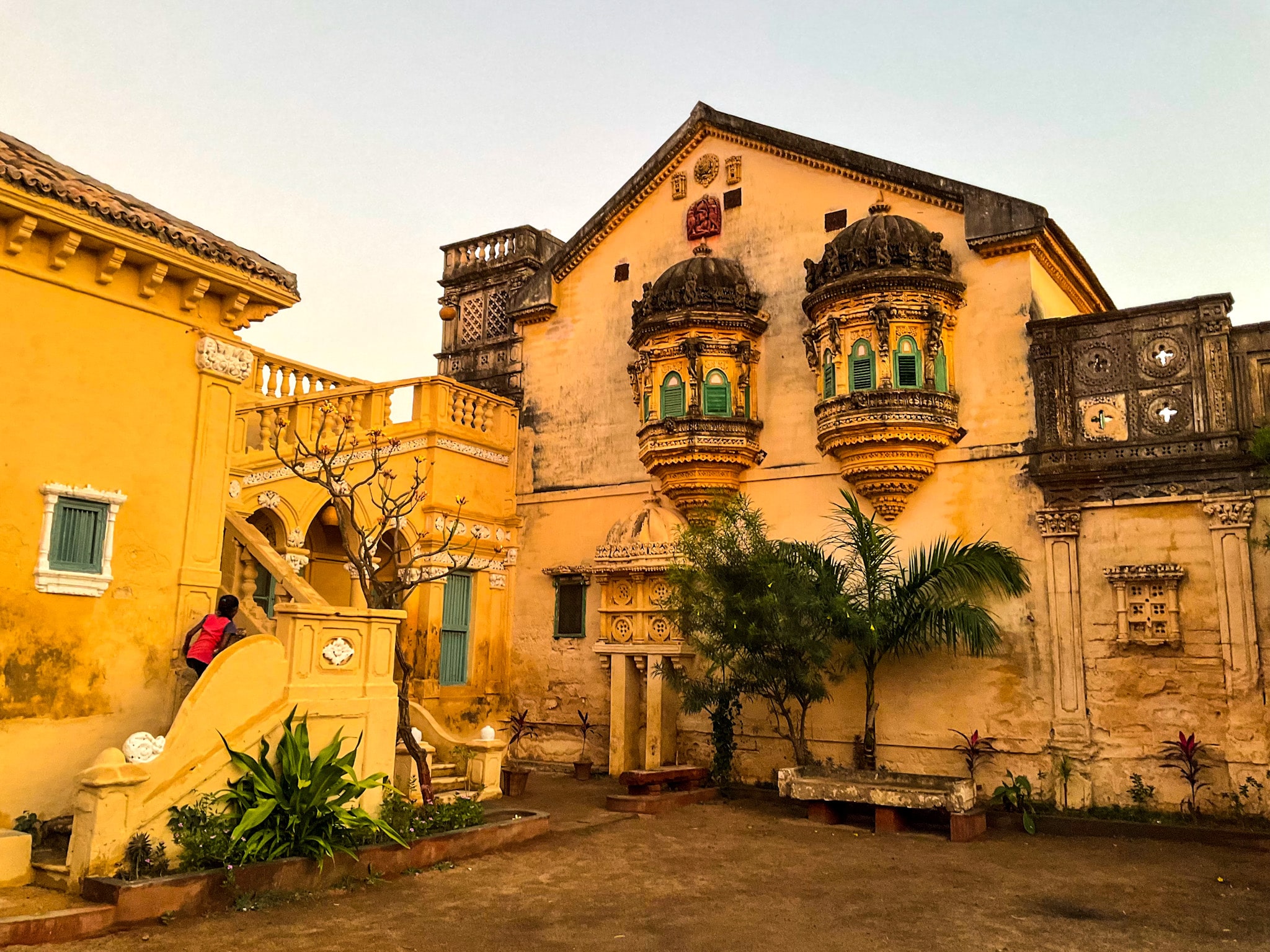Tourism in Gujarat doesn’t have to be just about Rann of Kutch. In this article, drawing from my own travel-route, I give you the best places to visit in Gujarat in the sustainable radar, where to stay for a local experience, and some travel hooks.
There was a line. The moon was getting aligned with Venus and Jupiter, getting there, from a bowed bend to a well-planned avenue, over the course of a week. There’s no stopping it, the natural discourse over my head. The only three white sparks in spots in an otherwise inky sky. I never lit the pink candle on the long blue candle-stand sitting on my work-table. My room had a vibration of pink and blue. And the 150-year-old Darbargarh in Kutch was my home for a month.

40 days of travelling across this region, from walking India’s only World Heritage City Ahmedabad to volunteering in a rural school in Kutch, more than the salt-deserts of The White Rann, I treasure the garba steps I couldn’t master, local women painting Mehendi on my palm and Krutarthsinh’s aunt’s parting gifts (sindoor!).
Let’s revisit the downtown lane with ideas for an inclusive and sustainable tourism experience in Gujarat that can transform a tick-off list into stories.
Which Places to Add to Your Gujarat Tourism List?
Wondering how to spend your time in a meaningful way? From Ahmedabad to Kutch – find your way through with the best of Gujarat!
1. Ahmedabad is India’s Only World Heritage City
Stay with A Local Family in Ahmedabad

I asked Vishesh, ‘Do you think it’s a good thing that Alcohol is banned in Gujarat?’ He nodded his head in disapproval. He had just poured a glass of rum, and offered it to me. ‘Yes and no. Mostly no. I can call a guy right away and get alcohol. And everybody does that. Of course, the price is almost three times that! The extra money goes to the bureaucrats only. You know, the fat guy gets fatter.’
‘I have a friend who lives in Ahmedabad. She feels really safe because alcohol is banned. She said she could be on the streets at night, and she would still feel safe.’
‘That’s true. Because you cannot drink on the streets. You can only drink from behind the curtains of your home.’
Yet, for the last 2 years, there has been an average of one rape and three crimes against women every day in Ahmedabad.
Inclusive of different perspectives, sharing a space with a Gujarati local would be a thought-provoking cultural exchange for you. Here is how you can connect with Vishesh through Couchsurfing to learn more about Ahmedabad’s tourist yet uncommon places.
A Heritage Walk Down the Lanes of Old Ahmedabad

Vav in Gujarati means stepwell. With 16 Stepwells for water-harvesting all over Ahmedabad, the subtlety of Hazrat Bai Harir Vav, more than the famous Adalaj Stepwell, made me appreciate stepwell-architecture of India even with more awe and inspiration. Five levels of carved stone floors lead to two small wells, and Persian and Sanskrit wall-inscriptions tell the story of Dhai Harir, the household lady who commissioned this Stepwell. Around the corner, her tomb and a mosque are also architecturally profound.

On my travels to Gujarat, the then-10-lakh-budgeted Jain Temple is truly the best white-marvel structure I have stopped over in Ahmedabad. It was initiated and planned by an opulent merchant Hutheesing Kesarisinh, no wonder the temple has bagged the pricey tag of ‘over a million dollars’. It’s a blend of the Solanki style of West Indian temple architecture with new elements of haveli architecture.
The mystery of Jhulta Minar is scientifically disoriented. “What they cannot unravel is when one minaret is shaken, the other begins to vibrate, though the connecting passage between the two remains vibration-free; what causes this vibration is unknown.” The interior of the adjoining Sidi Bashir Mosque is multi-arched in the Gothic Muslim theme blended with shades of Rajputana style.

Among many other heritage architectural monuments of Old Ahmedabad, the stepwells, Hutheesing Jain Temple and Jhulta Minar were the highlights of my walk down the heritage road. You can also book an organized heritage walk for an inclusive history-experience in Ahmedabad.
Also, Vishesh shared a dedicated Gujarat tourism guide with me that could be of great help to you, as it includes places only he knows of as a born-and-brought-up local!
Sip in Tea at A Graveyard in Ahmedabad Gujarat

A sturdy tea trunk and two-three souvenir graves covered in green Muslin clothes, Ktl Mohammad from Calicut laid the foundation of his tea stall in the 1950s in a graveyard. Lucky Tea Stall. The size of the restaurant has expanded, with less of the eeriness of a graveyard, and more of tasty ‘Bun Maska’ and tea.
Authentic Gujarati Thalis at Local Eateries

Khakra, Fafra, Dabeli – the regional cuisine has lots of special snacks and sweets. In Ahmedabad, my Couchsurfing host Vishesh used to bring local breakfast for all his Couchsurfers. But you can try out the Gujarati thali at some of these local restaurants – Agashiye, Gordhan Thal, Toran Dining Hall, Rajwadu and Havmor Restaurant. If you are in Ahmedabad, don’t forget to add these local eateries to your Gujarat itinerary!
2. Tourism in Gujarat is Incomplete Without Patan’s Rani ki Vav

As I travelled all the way from Ahmedabad to Patan just for that one glimpse of the finest craftsmanship of Rani Ki Vav, I knew what I was hoping for. Rani Ki Vav or ‘The Queen’s Stepwell’ on the banks of River Saraswati is a distinctive reminder of the human engineering of ancient water storage systems. All these years, this marvel lay buried under slit, before the excavation in 1960. This mammoth step-well has over 500 sculptures with more than 1000 estimated small sculptures. This upside-down temple converges to the well in seven steps. Take out a 100-rupee-note to see this memorial from the 11th century AD.
Also read – Girls Get Married at the Age of Nine in Rajasthan
3. Know the Rural Kutchi Culture by Volunteering in Devpur
“Before the invention or the introduction of the Western Railways, Mandvi in Kutch was one of the important ports. They also used to repair the boats. So any of the sails coming from the Western parts had to stop at Mandvi. They would trade, and proceed with the journey.’ That was my first introduction to the Kutch region of Gujarat.
There was a line. The moon was getting aligned with Venus and Jupiter, getting there, from a bowed bend to a well-planned avenue, over the course of a week. There’s no stopping it, the natural discourse over my head.
That one time Holi found me in Kutch, I didn’t miss the chance to pick up a few Garba steps. As my students turned into Garba teachers for the day, our empty dusty-ground painted colours to our faces, hands, and teeth. Krutarthsinh Ji’s 150-year-old ancestral house-cum-homestay withstood the colour-rain in unregulated hard-to-gets.
You Can Stay in the Locally-Run Devpur Homestay in Kutch

Looking for a local stay in Kutch Gujarat? The three-generational family-run Devpur Homestay in Village Devpur can be as cliché and true as ‘your home away from home’. Krutarthsinh Ji’s mother will welcome you to the family with teekas and marigold-garlands, and your stay will be at the Kutch-Roha styled Darbargarh (a small manor) that has survived the 2001 fatal earthquake. And primarily, you can roam around a Kutchi village still smelling of cow-dung, traditionally-clothed women, and orange sun-downs. Krutarthsinh Ji is the host for you at Devpur Homestay.
To learn in more detail about the historical and cultural introspection of Devpur Homestay, read this article at The Better India authored by me.
You Can Volunteer in their School as A Teacher

Krutarthsinh’s father was a Mathematics teacher, and this CBSE-affiliated English Medium School was the brainchild of his desire to craft a learning platform in his own village. The White Eagles School founded its first brick in 1960, and continues to run with 60 students from Devpur and nearby villages. Any learning help would be humbling, as outsiders bring exposure and possibility to a monotonic edu-pace. As a volunteer, you spend 4-5 hours for 5 days a week with the children, and dine and stay with the Jadeja family (that is, your food and accommodation will be taken care of by the family free of cost). Again, reach out to Krutarthsinh Sir to get a clearer idea – 9825711852.
Also read – Volunteer Tourism And How It Can Change Your Travel Experiences
4. Rann of Kutch Has Been Immensely Promoted by the Gujarat Tourism Board
In Shriraj’s words, ‘They (the Kutchi people) realized that agriculture is not something that can support the financial aspects of the Kutch region. So, from the very beginning, they started promoting trade. They involved all the communities. Everyone was involved in the trading of spices, handicrafts and everything. And there was a trade triangle between Kutch, Africa and Oman. We used to import a lot of elephant tasks from Zanzibar in Africa. In Oman, it was the trading of textiles and spices.’ Shriraj is the present architect of Pragmahal, the Royal Palace of Kutch, a historical stopover in Gujarat tourism.

Water recedes, and the surface of salt resurfaces. Climate change has also prominently surfaced with human stupidity; even in February, the desert was more watery than salty.
‘Road to Heaven’ – how the soaring words have termed the new road that moves through the white crystalline salt-desert on both sides! As we drove in Shriraj’s Thar, the salt-lands began to congeal as white, open and untended; whiter than the white sky forcibly joining hands. Welcome to the Great Rann of Kutch – one of the largest salt-deserts in the world.
5. Explore the Ancient Harappan Civilization of Dholavira
Dholavira is an island in the Rann of Kutch, toting ruined evidence of the Harappan Civilization or the Indus Valley Civilization. ‘The languages got lost. They did not teach anybody. They are written only in memory, pillars and stones. Who can read it?’ The local guide from Dholavira grieves. He has worked alongside the team for 40 years in digging up this historical whiff of an entire civilization.

Archeologists believe that Dholavira was an important centre of trade between the settlements in South Gujarat, Sindh and Punjab, and Western Asia.
– ‘Would they work on the site now?’
– ‘Let’s see. It has gone to the UNESCO now. Here people don’t want to invest in the dead.’
We passed up and down the long channel of antique filtering system, and witnessed the water-engineering of a civilization from the Bronze Age. Our guide points at a smoother-than-a-pebble stone, shaped in the namesake of a dhol. ‘This is limestone. It has a cutting at a 90-degree angle. This curve is like a machine-cut, yet it’s not.’
6. Kadiya Dhro is A Remote Canyon in Kutch Gujarat
The rain won’t stop blabbering, in the interim moments when I found shelter under a random giant rock that hardly had any intention of protecting my hips or bones. And the canyon, against the clouds, had only one tune ‘Bade Acche Lagte Hai’.

Kotaro is a Kutchi word for rock formations designed by wind and water. The cleavaged rock-cloves were formed through ages of exposure to strong wind and river flow.
‘If you go, you will get lost, and you will recover something of your own.’ Those were the words of Varun Suchday, the local Kutchi explorer who put Gujarat’s Kadiya Dhro on the world map, and more famously on The New York Times’ ‘52 Places to Love in 2021’.
Your own cars and other vehicles can only reach a certain point. And for the last 5 km stretch of kaccha road, you have to hire a jeep (readily available then and there) to reach the canyon (Rs. 800 for the entire jeep that can accommodate 4-5 people).
Also read – Locals Conserving Camels near Jaisalmer Rajasthan
7. Buy Local Handicrafts And Paintings near Bhuj

What better way to directly contribute to the locals’ revenue streak than purchasing local products? Tourism in Gujarat can be a walk into the handicraft villages and buying the craft directly from the artisans. Oh, and millet is the specialty of Kutch.
- Bhujodi is the ‘Weaver Village’ in Kutch
Known as the ‘Weaver Village’, every house in Bhujodi is involved in the craft of textile and Handloom. Meet the Vankar community who are specialists in weaving, tying and dying. This more than 500-year-old village advocates indigenous exposure to their generational handicrafts to outsiders through its vast marketspace.
- Ajrakhpur for Block Printing
Stop by Ajrakhpur for block printing. Block printing is a 3000-year-old craft that uses natural dyes made of indigo, henna, turmeric, pomegranate and mud to create fabric. Head to this Kutchi village to buy block-printed souvenirs!
- Where Would You Find Rogan Art in Kutch?
The answer is Nirona. The Khatri family will greet you at their workshops to witness the Rogan Art process. It’s your chance to purchase authentic Rogan Art pieces promptly from the artisans.

8. Lastly in Gujarat Tourism, Why Not Go for A Safari at Gir National Park?
Although I myself haven’t been to Gir National Park on my travels in Gujarat, a safari to this wild haven would draw you near Asiatic lions, leopards, jungle cats, Chital, Wild boars and striped hyenas. Book a safari online, and don’t forget the responsible practices around wildlife tourism. Respect the wilderness by leaving no plastic packets behind, don’t disturb the sanctity of this world with unnecessary noise, and don’t engage in riding an animal for commercial reasons! Stay at Gir Vanraj Farm in Bhojade with a local host at a homestay.
Water recedes, and the surface of salt resurfaces. Climate change has also prominently surfaced with human stupidity; even in February, the desert was more watery than salty.
When is the Best Time to Visit Gujarat?

Tourism in States like Gujarat and Rajasthan is season-specific unless you want to get boiled in the desert-heat. November to February is the best time to visit Gujarat, as the weather is pleasant and bearable.
How to Reach Gujarat
How to Reach Gujarat by Flight

Gujarat has 17 airports, with Sardar Vallabhbhai International Airport being the closest to Ahmedabad. Various airports across the state, including Bhuj, Vadodara, Surat, Bhagvanagar, Junagarh, and Rajkot, host daily and weekly flights, operated by around 14 airlines such as Jet Airways, Indigo, Emirates, Spice Jet, Singapore Airlines, and Air India.
You can always choose either a train or a bus to travel to any city within this region. Inter-state buses also are available all the time, both online and offline.
Tourism in Gujarat is diversified, as the region itself is of no one-go. Do you have a recommendation? Or do you know about any local, sustainable and volunteer-inclusive experience that can make your journey even more grounded? Let me know!
Make sustainable and responsible travel choices on your travels to Gujarat!
Support my solo adventures across the globe by joining the Patreon community!
Live the Adventure
Get weekly articles delivered to your doorstep and stay up-to-date with my new travel stories.
2 responses to “Tourism in Gujarat Can Be Sustainable with These Places”
-
The combination of volunteering in the school with a homestay sounds like a great way to immerse yourself in the local cultural.
-
Yes, and the homestay itself is a heritage building 150 years old.
-





Leave a Reply